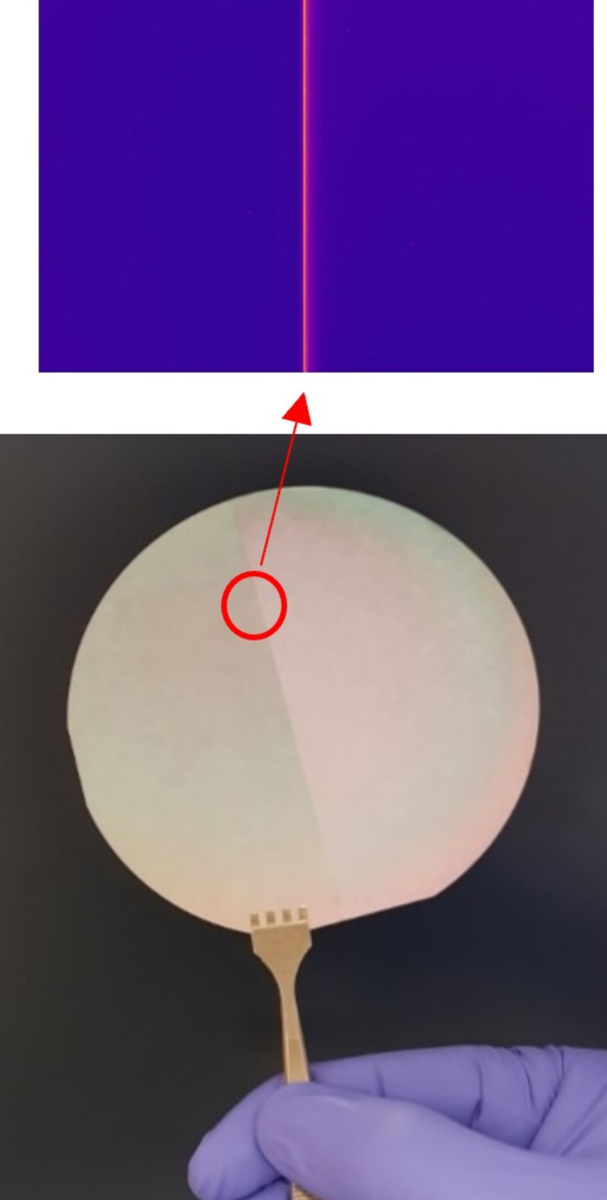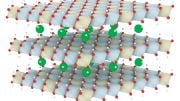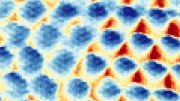
Researchers developed a novel method to control thermal emission at a designed interface. Pictured here as a wavy red line, the interface can be designed to any shape. Credit: Provided by Coskun Kocabas/The University of Manchester and Sahin Ozdemir/Penn State
Researchers state that finely crafted interfaces provide innovative design approaches that go beyond traditional materials, with potential applications in infrared optics, sensing, and other areas.
Researchers have engineered a method to precisely control thermal emissions, potentially transforming thermal management and camouflage technologies. This innovative approach, using topology and non-Hermitian photonics, shows significant promise for applications in satellite technology and beyond.
If a material absorbs light, it will heat up. That heat must go somewhere, and the ability to control where and how much heat is emitted can protect or even hide such devices as satellites. Researchers from an international team, including members from Penn State, have devised a new technique to regulate this heat release. They believe their method holds significant potential for advancing thermal management and thermal camouflage technologies.
The team recently published their findings in the journal Science.
Led by researchers at The University of Manchester’s National Graphene Institute in England and the Penn State College of Engineering in the United States, with experts from Koc University in Turkey and Vienna University of Technology in Austria, the team demonstrated a way to build an interface that joins two surfaces with different geometric properties to localize thermal emissions from both surfaces, enabling a “perfect” thermal emitter. This means that the designed platform can emit thermal light from contained, designated emission areas with unit emissivity, or that the platform emits the strongest thermal radiation possible at that temperature.
“We have demonstrated a new class of thermal devices using concepts from topology — a branch of mathematics studying properties of geometric objects — and from non-Hermitian photonics, which is a flourishing area of research studying light and its interaction with matter in the presence of losses, optical gain, and certain symmetries,” said corresponding author Coskun Kocabas, professor of 2D device materials at The University of Manchester.
Achievements and Challenges
The team said the work could advance thermal photonic applications to better generate, control, and detect thermal emission. One application of this work could be in satellites, said co-author Sahin Ozdemir, professor of engineering science and mechanics at Penn State. Faced with significant exposure to heat and light, satellites equipped with the interface could emit the absorbed radiation with unit emissivity along a specifically designated area designed by researchers to be incredibly narrow and in whatever shape is deemed necessary.
Getting to this point, though, was not straightforward, according to Ozdemir. He explained part of the issue is limiting the perfect thermal absorber-emitter to the interface while the rest of the structures forming the platform remains “cold,” meaning those structures do not absorb or emit any form of energy.

Researchers can alter the thickness of the platinum layer, shown here as a silver circle, with one side thicker than the other. By altering the thickness, the two sides are brought to a “critical coupling” point, where light absorbed by either side can be emitted together at the meeting point. That meeting point releases the thermal radiation in whatever shape the researchers determine. Here, it is shown as a thin red line. Credit: Provided by Coskun Kocabas/The University of Manchester and Sahin Ozdemir/Penn State
“Building such a perfect absorber-emitter has been a major challenge,” Ozdemir said.
It is slightly easier to build an absorber-emitter at a desired frequency — as opposed to a perfect absorber-emitter that can absorb and emit any frequency — by trapping the light inside an optical cavity, the researchers said. The optical cavity comprises two mirrors, the first of which only partially reflects light, while the second completely reflects light. This setup enables what researchers call the “critical coupling condition,” where the incoming light partially reflected by the first mirror and the reflected light trapped between the two mirrors cancel each other out exactly. This completely suppresses the reflection, so the light beam becomes trapped in the system, getting perfectly absorbed and then emitted in the form of thermal radiation.
Innovative Interface Design
“We took a different approach in this work, though, by bridging two structures with different topologies, meaning they absorb and emit radiation differently,” Ozdemir said. “The structures are not at the critical coupling point, so they are not considered a perfect absorber-emitter — but their interface exhibits perfect absorption and emission.”
To achieve such an interface, the researchers developed a cavity stacked with a thick gold layer that perfectly reflects incoming light and a thin platinum layer that can partially reflect incoming light. The platinum layer, which comprises two separate thicknesses stitched together, also acts as a broadband thermal absorber-emitter. Between the two mirrors, the researchers placed a transparent dielectric, or material that insulates against electrical conductivity, called parylene-C.
The researchers can adjust the thickness of the platinum layer as needed to induce the critical coupling condition at the stitched interface and trap incoming light to be perfectly absorbed. They also can move the system away from the critical coupling to sub- or super-critical coupling, where perfect absorption and emission cannot take place.
“By finely tuning the thickness of the platinum layer to a critical thickness of about 2.3 nanometers, we bring the cavity to the critical coupling condition where the system exhibits perfect absorption and, as a result, perfect emission,” said first author M. Said Ergoktas, a research associate in materials engineering at The University of Manchester. “Only by stitching two platinum layers with thicknesses smaller and larger than the critical thickness over the same dielectric layer, can we create a topological interface of two cavities where perfect absorption and emission are confined. A crucial point here is that the cavities forming the interface are not at critical coupling condition, but that the interface itself is.”
The development challenges conventional understanding of thermal emission in the field, according to co-author Stefan Rotter, a researcher at the Vienna University of Technology in Austria.
“Every hot object radiates heat in the form of incoherent, random light,” Rotter said. “Traditionally, it has been believed that thermal radiation cannot have topological properties because of its incoherent nature.”
This work, however, demonstrated that thermal emission can be engineered to have topological characteristics, which can create strongly confined states of light that emit only from the topological interface between two surfaces. The researchers said they also can design the parameters of the interface to any shape, from a narrow line to something more complicated, like the outline of the United Kingdom.
According to Kocabas, their approach to building topological systems for controlling radiation is easily accessible to scientists and engineers.
“This can be as simple as creating a film divided into two regions with different thicknesses such that one side satisfies sub-critical coupling, and the other is in the super-critical coupling regime, dividing the system into two different topological classes,” Kocabas said.
The realized interface exhibits perfect thermal emissivity, which is protected by the reflection topology and “exhibits robustness against local perturbations and defects,” according to co-author Ali Kecebas, a postdoctoral scholar at Penn State. The team used experiments and numerical simulations to confirm the system’s topological features, as well as the non-Hermitian physics underpinning how the system works.
Reference: “Localized thermal emission from topological interfaces” by M. Said Ergoktas, Ali Kecebas, Konstantinos Despotelis, Sina Soleymani, Gokhan Bakan, Askin Kocabas, Alessandro Principi, Stefan Rotter, Sahin K. Ozdemir and Coskun Kocabas, 6 June 2024, Science.
DOI: 10.1126/science.ado0534
Contributors include Sina Soleymani, who earned a doctorate in engineering science and mechanics from Penn State in 2021 when the first phases of this work were completed; Konstantinos Despotelis, Gokhan Bakan and Alessandro Principi, University of Manchester; and Askin Kocabas, Koc University, Turkey.
The European Research Council, Consolidator Grant, the Air Force Office of Scientific Research Multidisciplinary University Research Initiative (MURI) Award on Programmable Systems with Non-Hermitian Quantum Dynamics and the Air Force Office of Scientific Research Award supported this work.









Be the first to comment on "A New Dimension of Heat: New Approach for Controlling Thermal Emission Developed"